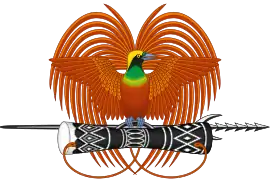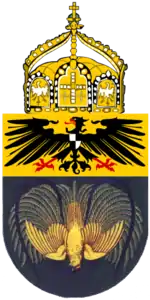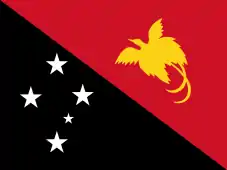Emblem of Papua New Guinea
The national emblem of Papua New Guinea consists of a bird-of-paradise over a traditional spear and a kundu drum. Designed by Hal Holman, an Australian artist working for the Papuan government, Holman was also involved in the design of the National flag. Both the emblem and the flag was accepted by the House of Assembly of Papua and New Guinea and signed into law as the National Identity Ordinance by the Administrator Sir Leslie Johnson on 24 June 1971. The ordinance came into effect after its publication in the Papua New Guinea Gazette of 1 July 1971.[1]
| Emblem of Papua New Guinea | |
|---|---|
 | |
| Armiger | Elizabeth II in Right of Papua New Guinea |
| Adopted | 1 July 1971 |
| Blazon | Bird-of-paradise proper |
| Compartment | Traditional spear and kundu drum |
Description
DESCRIPTION OF THE NATIONAL EMBLEM.[2]
The Papua New Guinea National Emblem is a partially-stylized representation of the widespread Bird of Paradise Genus paradisaea in display, head turned to its left, seated on the upturned grip of a horizontal Kundu drum with the drum-head to the right side of the bird, from behind which a horizontal ceremonial spear projects with the head to the left of the bird.
If coloured proper, the following colours should be used –
BIRD OF PARADISE
- Head …. …. …. …. …. Yellow
- Bill …. …. …. …. …. Grey-Blue
- Neck …. …. …. …. …. Black
- Breast …. …. …. …. …. Green with yellow band
- Abdomen …. …. …. …. …. Light brown, darkening to vent
- Wings and long tail feathers …. …. Brown (reddish)
- Display plumes …. …. …. …. …. Deep red (slightly brownish)
SPEAR
- Black, with white highlights.
KUNDU DRUM
- Drum head …. …. …. …. …. White
- Body …. …. …. …. …. Black, with white ornamentations
- Grip …. …. …. …. …. Black, with white highlights.
History
|
| ||||||||||||||||||||||||||||||
| Papua New Guinea | ||
| Emblem | Period of use | Notes |
|---|---|---|
 |
1949 – 1971 | The coat of arms of Australia was used by the territory after the Papua and New Guinea Act 1949 united the two administrative areas into one territory; the Territory of Papua and New Guinea. |
.svg.png.webp) |
1971 – present | On 1 July 1971 the National Identity Ordinance was passed into law by the House of Assembly. The ordinance introduced a new emblem for the territory, which was retained after independence by Papua New Guinea as an independent Commonwealth realm in 1975. |
See also
| Wikimedia Commons has media related to Coats of arms of Papua New Guinea. |
| Wikimedia Commons has media related to Historical coats of arms of Papua New Guinea. |
References
- de Vries, Hubert (2013-03-21). "PAPUA - NEW GUINEA". www.hubert-herald.nl. Retrieved 2017-07-17.
- Papua New Guinea Consolidated Legislation, National Identity Act 1971
- Herzfeld, Andreas. "Die Wappen- und Flaggenentwūrfe fūr die deutschen Kolonien" (PDF). Retrieved 2017-07-17.
This article is issued from Wikipedia. The text is licensed under Creative Commons - Attribution - Sharealike. Additional terms may apply for the media files.


.svg.png.webp)
.svg.png.webp)
.svg.png.webp)
.svg.png.webp)
